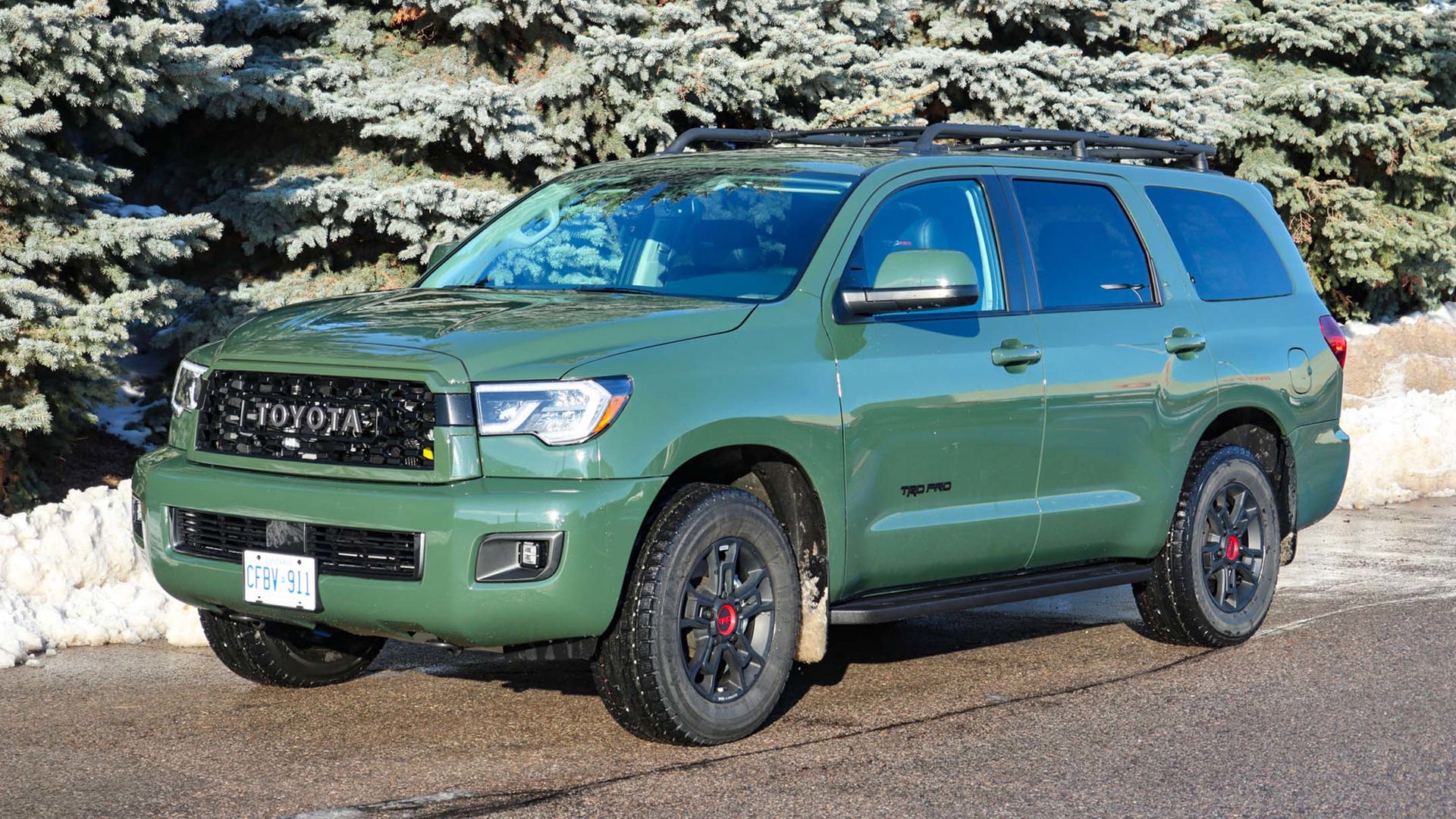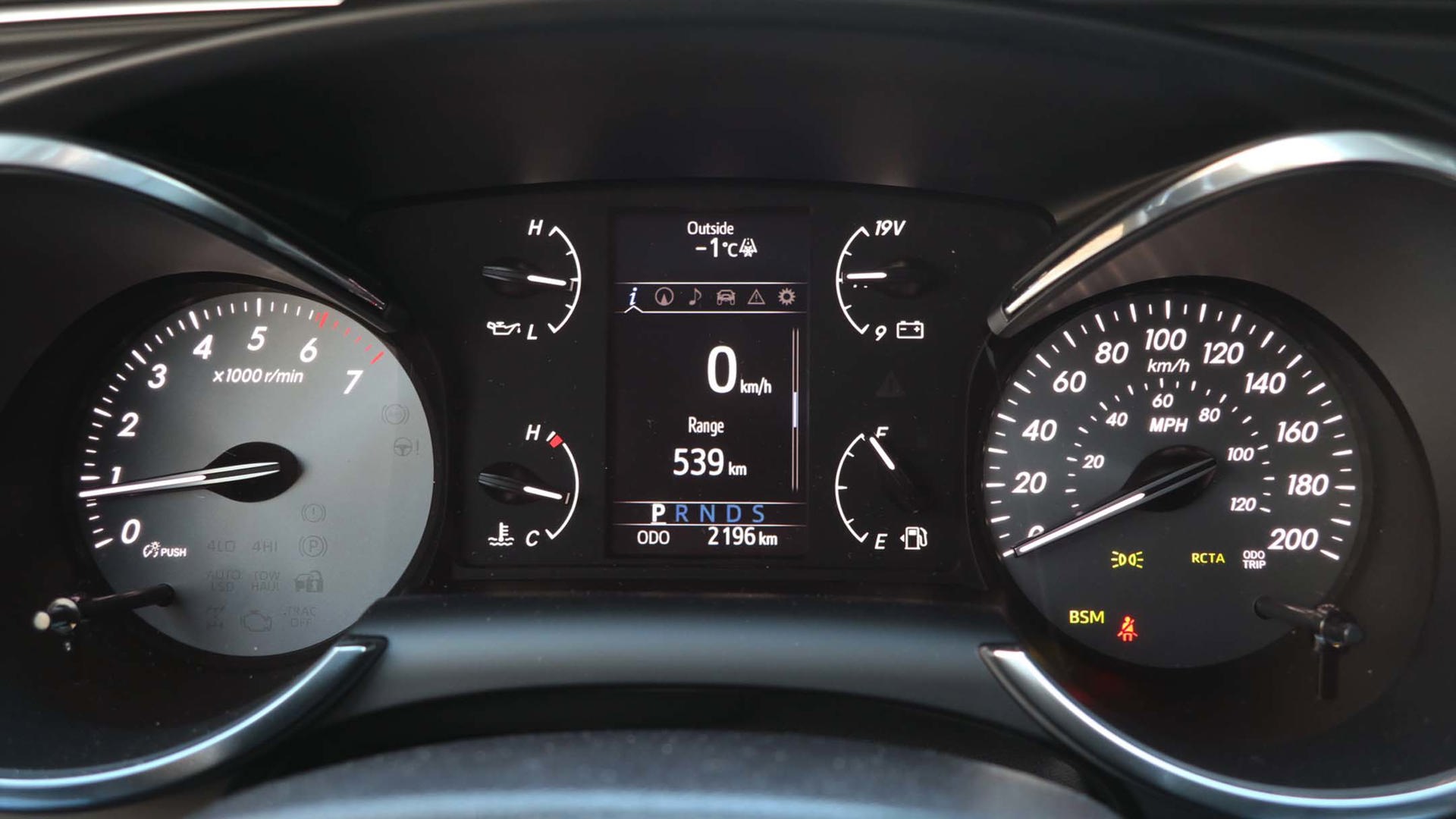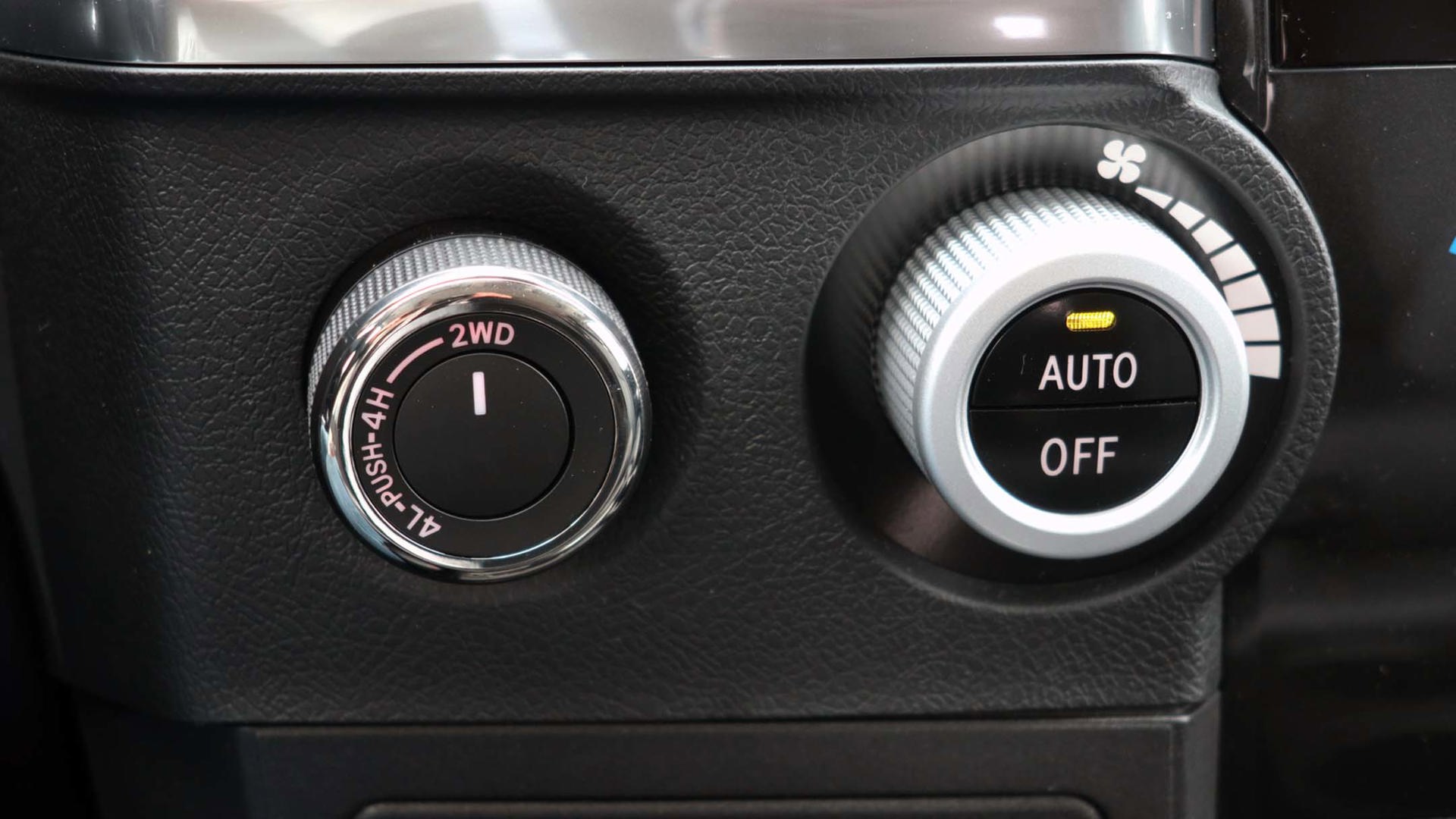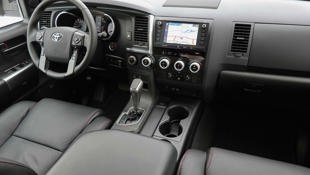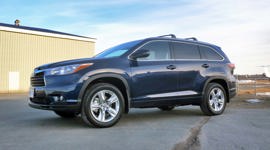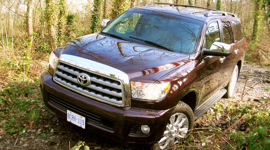 AutoTrader SCORE
AutoTrader SCORE
-
STYLING7/10
-
Safety8/10
-
PRACTICALITY8/10
-
USER-FRIENDLINESS9/10
-
FEATURES8/10
-
POWER8/10
-
COMFORT9/10
-
DRIVING FEEL8/10
-
FUEL ECONOMY4/10
-
VALUE6/10
Go big or go home, as they say, and at Toyota, you can’t get any bigger than the Sequoia. This three-row sport-ute is based on the Tundra, and it muscles into 2020 with a new TRD Pro Package, on top of the TRD Sport Package that carries over from last year.
The Sequoia comes in three trim levels, but the TRD packages are only available on my tester, the base SR5 trim. That model starts at $63,290, but my TRD Pro Package added a majorly $15,660 to it, bringing it to $78,950 before freight and taxes.
Styling: 7/10
The TRD Pro option adds some nice features, including the so-called “heritage” grille, 18-inch forged wheels, Rigid Industries fog lamps, and a tubular roof rack. But the Sequoia is an older model – it’s only in its second generation from its initial introduction in 2001, and while it was refreshed a couple of years ago, its last full makeover was in 2008. It looks dated as a result, especially with its wide-eyed round taillights.
Still, its brick-like shape has its advantages, including full headroom all the way to the rear, and a wide liftgate opening. And while some sport-ute rear hatch windows pop open and lift up, the Sequoia back window is the same as the Tundra’s: It retracts right down into the bottom of the liftgate panel, like a conventional power window.
Safety: 8/10
Toyota includes a suite of active safety features in all its vehicles. Exactly what you get can vary, but the Sequoia’s bundle comes standard with emergency braking with pedestrian detection, lane-departure warning, adaptive cruise control, and automatic high-beam headlamps.
On top of that, all Sequoia models include blind-spot monitoring and a tire pressure monitoring system, as well as the rear-view camera now required on all new vehicles. But you have to add a TRD package on the SR5 to get front and rear sonar sensors to help with distances when parking, or move up to the Limited or Platinum trims.
Practicality: 8/10
I’m giving it the score I did based not on how practical it is to park in narrow quarters, but on how that big footprint makes it ideal if you need a lot of passenger and cargo space. With the third row upright you get 535 L of space, while both the second and third rows fold down for an almost pickup-truck-style cargo area. The liftover is low, making it easy to load items inside, and power-folding third-row seats are standard. And if you’ve got more than that to carry, the SR5 can tow a maximum of 7,099 lb (3,220 kg).
Up front, the Sequoia shares the Tundra’s huge centre console, which, in keeping with its ability as a work truck, is sized to fit hanging files. The front door armrests have little flip-out storage cubbies, and there are three cupholders up front. The only oddity is a long panel lid in the front console that’s removable to reveal what looks like a cubby for holding pens, but it reaches all the way under the cupholders. Should something slide to its farthest reaches, good luck retrieving it.
User Friendliness: 9/10
The Sequoia is dead-simple to operate, and that’s always a plus for me. The climate settings are controlled by huge dials that are easily grasped while wearing gloves, as is the dial that switches between two- and four-wheel drive. The infotainment system is also easy to figure out, with large icons and straightforward instructions, and you switch between the functions using hard buttons on either side of the screen.
There are only a couple of quibbles where things could be even easier. The heated seats have small dials that must be awkwardly rolled with one’s fingers, and while all the window and lock switches on the door are lit up, the mirror switch is not.
Features: 8/10
The Sequoia comes fairly well-kitted, even in the entry SR5 model. There’s a 10-way power driver’s seat, leather upholstery, auto-dimming mirror, three-zone automatic climate control, sunroof, running boards, the aforementioned active safety features, seven-inch touchscreen, satellite radio, and Apple CarPlay and Android Auto.
You must move into the Limited or Platinum if you want items such as an auto-levelling rear suspension, rear-seat entertainment, or heated rear seats, which aren’t available even as options on the SR5. Oddly, given its popularity with Canadian drivers, a heated steering wheel isn’t available on any model – a fair bit of an oversight given the vehicle’s price.
The TRD Pro package is a mixed bag of items. There are second-row captain’s chairs in place of a bench seat, Fox shocks, a unique grille, LED headlamps and fog lamps, and 18-inch black alloy wheels, along with navigation, a 14-speaker premium audio system, traffic and weather connected services, and front and rear clearance sonar. But at $15,660, it’s a pricey add-on.
Power: 8/10
The sole powerplant is a 5.7L V8, making 381 hp and 401 lb-ft of torque, mated to a six-speed automatic transmission. That puts it about mid-pack with most of its mainstream big-box competitors: More torque than the 394 lb-ft put out by the Nissan Armada’s 5.6L V8 or the Chevy Suburban’s base 5.3L V8, which makes 383 lb-ft, but it ranks below the Suburban’s optional 6.2L V8 (460 lb-ft) or Ford’s Expedition (470 lb-ft).
The Sequoia uses a part-time four-wheel drive system that’s easily controlled by a dial on the dash. The system is for soft surfaces or deep snow only, and driving it in four-wheel drive on dry asphalt can bind and damage the system. An automatic setting that can be used on all surfaces would be handy on roads with alternating patches of dry and snow or puddles, but on SUVs that offer it, it’s usually on the highest trim levels, and isn’t available on any of the Sequoia’s models.
Comfort: 9/10
“Comfortable” is the Sequoia’s middle name. The front seats are supportive, and when I put an adult passenger into a second-row captain’s chair, he reported the same thing over the course of an hour and a half, especially since he had his own climate controls.
The third-row seats are flatter and firmer than those in the two front rows, but they’re still comfy nevertheless. Unlike in many SUVs, they’re easy to access and you get a lot of legroom, even for adults. There really isn’t much of a penalty if you’re relegated to the back row in this machine.
Driving Feel: 8/10
It’s definitely not an enthusiast’s vehicle, but the Sequoia responds well to steering inputs and handles well for its size. You’ll have to forgive its lack of steering feedback, but it has a surprisingly tight turning circle that improves its manoeuvrability.
The ride is comfortable – if a bit floaty – and you can feel the Fox shocks soaking up the bumps. I like its big-and-smooth performance, especially on a longer highway drive.
Fuel Economy: 4.5/10
The Sequoia consistently rates high in reliability studies, and part of that is no doubt due to its engine being around for so many years that any kinks were ironed out a long time ago. But it also hasn’t been updated much in the way of fuel-saving technologies or more transmission gears, and so it’s rather thirsty.
The Sequoia is rated at 18.5 L/100 km in the city and 13.9 on the highway by Natural Resources Canada (NRCan). In my week with it, I racked up 18.3 L/100 km. Its official city/highway rating is 16.4, putting it well behind competitors like the Armada (15.4), Suburban (14.6) and Expedition (12.5).
Value: 6/10
Nothing in this XL-sized segment is inexpensive, but with a starting price of $63,290 – a jump of $1,925 over the 2019 model – the 2020 Sequoia sits near the top of the pack. You can pick up a GMC Yukon for $57,398 (or the longer-bodied XL for $60,398), or Ford’s Expedition starting at $62,500. Nissan’s base Armada has a few more features than the Toyota but starts higher at $65,898, which no doubt reflects the considerably lower volumes that the Japanese automakers sell of these, versus their Detroit competitors.
The Sequoia has typically kept a high resale value, which is a bonus, but the $63,290 base price often seemed at odds with the vehicle’s dated feel and lack of some features you’d expect for the price, such as a heated steering wheel or navigation. And while I like the enhanced appearance and ride quality provided by the TRO Pro package, at $15,660, I could almost buy a Yaris for it.
The Verdict
The longer I lived with the Sequoia, the more it grew on me. I very much liked its comfortable interior, its smooth ride, the way it gobbled up cargo, and the simplicity of its controls. The big, body-on-frame sport-ute is a small slice of the market with only a few competitors, so if you need something this big, take a look at all of them. Toyota’s version has its shortcomings, but it’s worth comparing.
| Engine Displacement | 5.7L |
|---|---|
| Engine Cylinders | V8 |
| Peak Horsepower | 381 hp @ 5,600 rpm |
| Peak Torque | 401 lb-ft @ 3,600 rpm |
| Fuel Economy | 18.5/13.9/16.4 L/100 km cty/hwy/cmb |
| Cargo Space | 535 / 1,886 / 3,400 L behind 3rd/2nd/1st row |
| Model Tested | 2020 Toyota Sequoia SR5 TRD Pro |
| Base Price | $63,290 |
| A/C Tax | $100 |
| Destination Fee | $1,815 |
| Price as Tested | $80,865 |
|
Optional Equipment
$15,660 – TRD Pro package, $15,660
|
|








